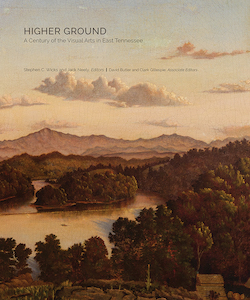Higher Ground
A Century of the Visual Arts in East Tennessee

- Author(s): Wicks, Stephen C., editor
- Series:
- Imprint: The Knoxville Museum of Art
- Publication Date: 2023-10-27
- Status: Active
- Available in Paper: Price $34.95 | Buy Now
Higher Ground: A Century of the Visual Arts in East Tennessee documents the Knoxville Museum of Art’s core collection of works by artists from or with close ties to East Tennessee from roughly the mid nineteenth to the late twentieth century. The book accompanies a permanent exhibition of the same name. Both book and exhibition make the case that the visual culture of Knoxville and its Appalachian environs is far more sophisticated, diverse, nuanced, and connected than most believe. KMA curator Stephen Wicks sets out the rationale behind Higher Ground and introduces the broad themes around which the book and exhibition are organized. Jack Neely, executive director of the Knoxville History Project, assembles a fascinating and richly detailed history of the visual arts in Knoxville. Dr. Robert Booker, an expert in local Black history, unearths a wealth of new information about Black artists in Knoxville, the hardships they endured, and their contributions to the story told by Higher Ground. And finally Dr. Susan Knowles surveys the history of the Tennessee marble industry, which is so closely intertwined with the region’s economic and cultural history.
Following the essays, the catalogue, with text by Wicks and lavishly illustrated with seventy-five full-page color plates, fixes around broad themes. “Grand Ambitions: Forging an Arts Community,” which encompasses the formation of a community of professional artists and their dialogue with contemporary currents of American art in the late nineteenth and early twentieth century, is built around pioneering Impressionist Catherine Wiley who, with Hugh Tyler and Lloyd Branson, organized some of the first major art exhibitions in the South. “Shaping a Regional Identity: Mountain Vistas and Urban Life,” features artists who documented the hardscrabble reality of industrial Knoxville (and includes such great photographers as Henri Cartier-Bresson and Danny Lyon) as well as majestic mountain landscapes (by Charles Krutch, Rudolph lngerle, and Ansel Adams) of the nearby Great Smoky Mountains. “Joseph and Beauford Delaney” celebrates the achievements of two prodigious Black artists who left their Knoxville hometown to achieve national and international prominence, with a particularly rich selection from Beauford’s Paris years of the 1950s and 1960s. “The Knoxville 7” focuses on a progressive group of disparate artists united by their common interest in cultivating Modernism in local soil in the 1950s and 1960s. A final section is dedicated to the work of Black artist Bessie Harvey, an East Tennessee visionary who rose from poverty to achieve national recognition late in the twentieth century.
